
Nassella seeds germinated in water to observe germination process. Photo credit: Fernando Agudelo-Silva
- Subject:
- Agriculture
- Biology
- Botany
- Forestry and Agriculture
- Material Type:
- Diagram/Illustration
- Author:
- Emily Fox
- Date Added:
- 06/10/2022

Nassella seeds germinated in water to observe germination process. Photo credit: Fernando Agudelo-Silva
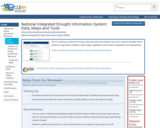
This is a extensive collection of maps, data, and tools that students can use to research drought and its impacts on agriculture, wildfires, water supply, vegetation, soil moisture, temperature and precipitation.

In this lesson, students will research one Native American group from each of the six main biomes in North America. Students will use their developing technology and language arts skills to find reliable sources on the internet, evaluate and integrate information from these texts, select a suitable digital platform to share their findings, and create a cohesive presentation showcasing their mastery of the learning outcomes. Students will discover the climate, landforms, water, and other natural resources available within each region and how they were used by the natives living there. Students will explore the relationships between the cultures found within each region and its resources. This unit was created as part of the ALEX Interdisciplinary Resource Development Summit.

In this video segment adapted from Haskell Indian Nations University, student filmmakers explain why it is important to them to make a video about climate change.

Students analyze the natural disaster threat and potential mitigation techniques of their (family) home.
(Note: this resource was added to OER Commons as part of a batch upload of over 2,200 records. If you notice an issue with the quality of the metadata, please let us know by using the 'report' button and we will flag it for consideration.)
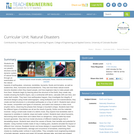
Students are introduced to our planet's structure and its dynamic system of natural forces through an examination of the natural hazards of earthquakes, volcanoes, landslides, tsunamis, floods and tornados, as well as avalanches, fires, hurricanes and thunderstorms. They see how these natural events become disasters when they impact people, and how engineers help to make people safe from them. Students begin by learning about the structure of the Earth; they create clay models showing the Earth's layers, see a continental drift demo, calculate drift over time, and make fault models. They learn how earthquakes happen; they investigate the integrity of structural designs using model seismographs. Using toothpicks and mini-marshmallows, they create and test structures in a simulated earthquake on a tray of Jell-O. Students learn about the causes, composition and types of volcanoes, and watch and measure a class mock eruption demo, observing the phases that change a mountain's shape. Students learn that the different types of landslides are all are the result of gravity, friction and the materials involved. Using a small-scale model of a debris chute, they explore how landslides start in response to variables in material, slope and water content. Students learn about tsunamis, discovering what causes them and makes them so dangerous. Using a table-top-sized tsunami generator, they test how model structures of different material types fare in devastating waves. Students learn about the causes of floods, their benefits and potential for disaster. Using riverbed models made of clay in baking pans, students simulate the impact of different river volumes, floodplain terrain and levee designs in experimental trials. They learn about the basic characteristics, damage and occurrence of tornadoes, examining them closely by creating water vortices in soda bottles. They complete mock engineering analyses of tornado damage, analyze and graph US tornado damage data, and draw and present structure designs intended to withstand high winds.
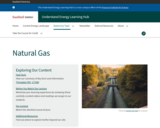
Natural gas (NG) is the most versatile and fastest-growing fossil fuel—used in all areas of the economy (industrial, residential, commercial, and transportation). It is a depletable, non-renewable resource composed primarily of methane gas (CH4), with smaller amounts of natural gas liquids, carbon dioxide (CO2), and water vapor. While natural gas is the cleanest-burning fossil fuel, it still produces CO2 when combusted. And because natural gas is primarily methane, it is itself a very potent greenhouse gas when it is emitted to the atmosphere uncombusted.

This activity is a field investigation on stream tables.
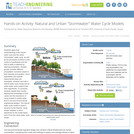
Students apply their understanding of the natural water cycle and the urban "stormwater" water cycle, as well as the processes involved in both cycles to hypothesize how the flow of water is affected by altering precipitation. Student groups consider different precipitation scenarios based on both intensity and duration. Once hypotheses and specific experimental steps are developed, students use both a natural water cycle model and an urban water cycle model to test their hypotheses. To conclude, students explain their results, tapping their knowledge of both cycles and the importance of using models to predict water flow in civil and environmental engineering designs. The natural water cycle model is made in advance by the teacher, using simple supplies; a minor adjustment to the model easily turns it into the urban water cycle model.

Through an overview of the components of the hydrologic cycle and the important roles they play in the design of engineered systems, students' awareness of the world's limited fresh water resources is heightened. The hydrologic cycle affects everyone and is the single most critical component to life on Earth. Students examine in detail the water cycle components and phase transitions, and then learn how water moves through the human-made urban environment. This urban "stormwater" water cycle is influenced by the pervasive existence of impervious surfaces that limit the amount of infiltration, resulting in high levels of stormwater runoff, limited groundwater replenishment and reduced groundwater flow. Students show their understanding of the process by writing a description of the path of a water droplet through the urban water cycle, from the droplet's point of view. The lesson lays the groundwork for rest of the unit, so students can begin to think about what they might do to modify the urban "stormwater" water cycle so that it functions more like the natural water cycle. A PowerPoint® presentation and handout are provided.

This resource is a video abstract of a research paper created by Research Square on behalf of its authors. It provides a synopsis that's easy to understand, and can be used to introduce the topics it covers to students, researchers, and the general public. The video's transcript is also provided in full, with a portion provided below for preview:
"Montmorillonite clay is an abundant and versatile natural nanomaterial. Formed of aluminum oxide sheets sandwiched between layers of silica, montmorillonite is prized for its tremendous absorption and antimicrobial properties, including by those in the pharmaceutical, cosmetics, and water purification industries. Some scientists even believe that the mineral was crucial to catalyzing the primordial reactions that gave rise to the first life forms on earth. Now, a recent study suggests that the same mineral could help breathe life into the economy of rural parts of Pakistan. Montmorillonite deposits are found all over the world, most notably in the Himalayan, Caucasus, and Andes mountains. But an abundant supply of raw clay also exists in the largely untouched mountains found in South Punjab in Pakistan. Here, heavy reliance on agriculture and low levels of industrialization have contributed to higher levels of poverty and unemployment compared with the rest of Punjab..."
The rest of the transcript, along with a link to the research itself, is available on the resource itself.
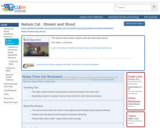
This cartoon shows where streams start and where they end up.
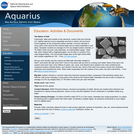
This is a hands-on lab activity about the composition of salt. Learners will explain the general relationship between an element's Periodic Table Group Number and its tendency to gain or lose electron(s), and explain the difference between molecular compounds and ionic compounds. They will then use household materials to build a model to demonstrate sodium chloride's cubic form and describe the nature of the electrostatic attraction that holds the structure of salt together. Background information, common preconceptions, a glossary and more is included. This activity is part of the Aquarius Hands-on Laboratory Activities.
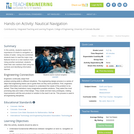
In this activity, students explore the importance of charts to navigation on bodies of water. Using one worksheet, students learn to read the major map features found on a real nautical chart. Using another worksheet, students draw their own nautical chart using the symbols and identifying information learned.

This map of the Navajo Nation illustrates settlements, landforms, water features, parks, forests, and neighboring Indian reservations. The map index provides links to additional information about some of these features.
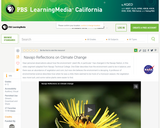
In this video segment adapted from Navajo Technical College, meet two members of the Navajo Nation, one Elder and one scientist, as they share their observations about how precipitation has changed since they were children.
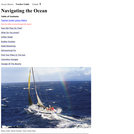
Navigational tools and methods of early voyagers provide the background and contrast to the satellite images and models used today. Students complete mapping activities based on historical data from Columbus and Blith. Students will also use a computer model of ocean currents to investigate the movement of objects drifting on the ocean surface. Note that this is lesson one of five on the Ocean Motion website. Each lesson investigates ocean surface circulation using satellite and model data and can be done independently. See Related URL's for links to the Ocean Motion Website which provide science background information, data resources, teacher material, student guides and a lesson matrix.
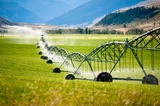
Video link and accompanying worksheet with answer key. Nebraska ranks #1 in both irrigated acres and groundwater abundance in the U.S. Water is the lifeblood of the state. This program, produced in cooperation with the Nebraska State Irrigation Association, explores the relationships between groundwater and surface water, the different ways in which we use it, and how we work together to manage water for future generations.

In this lesson, the students will build a shelter in order to protect themselves from the rain. After the shelters are built, the class will perform durability and water proof testing on the shelters.

Learn about the formation of clouds, types of clouds, the water cycle and wind patterns. Then complete a worksheet to check your knowledge about clouds. Student OER: Jennifer Park, Author